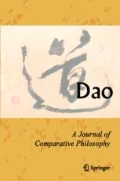Abstract
The present essay examines the conflicting ontological assumptions that one can find behind the word dao in the texts of the Laozi and Zhuangzi and argues that the relative indifference to these texts toward whether or not dao has an ontic reality should not be considered a flaw of early Daoism. Rather, the historical process by which the term dao collects various possible ontological implications can be thought of as a philosophical stance in its own right. That is, if the terms which one is obliged to use in discussing the immaterial necessarily hide, at least as much as they explain, the nature of Being, then it is a reasonable response to decline to ground one’s ethics in an ontology, and that while the resulting philosophy may not qualify as a fully-adumbrated system, this does not diminish its potential usefulness.
Similar content being viewed by others
References
Chen, Guying 陳鼓應. 1975. Contemporary Annotation and Interpretation of the Zhuangzi 莊子今註今釋. Taipei 臺北: Taiwan Shangwu 台灣商務.
Fried, Daniel. 2007. “A Never-Stable Word: Zhuangzi’s Zhiyan and ‘Tipping-Vessel’ Irrigation.” Early China 31: 145–170.
Graham, A.C. 1978. Later Mohist Logic, Ethics, and Science. London: School of African and Oriental Studies.
_____. 1989. Disputers of the Tao: Philosophical Argument in Ancient China. La Salle, IL: Open Court.
Hansen, Chad. 1992. A Daoist Theory of Chinese Thought: A Philosophical Interpretation. New York: Oxford Unviersity Press.
Hobbes, Thomas. 1651. Leviathan, or, The Matter, Form, and Power of a Common-wealth Ecclesiastical and civil. ProQuest: Early English Books Online. http://gateway.proquest.com.login.ezproxy.library.ualberta.ca/openurl?ctx_ver=Z39.88-2003&res_id=xri:eebo&rft_id=xri:eebo:image:62954:14.
Laozi. 1963. Tao Te Ching. D.C. Lau, trans. London: Penguin.
Liu, Xiaogan. 1994. Classifying the Zhuangzi Chapters. Ann Arbor: Center for Chinese Studies.
Wang, Youru, ed. 2007. Deconstruction and the Ethical in Asian Thought. New York: Routledge.
Watson, Burton, trans. 1968. The Complete Works of Chuang Tzu. New York: Columbia University Press.
Yeh, Michelle. 1983. “The Deconstructive Way: A Comparative Study of Derrida and Chuang Tzu.” Journal of Chinese Philosophy 10: 95–126.
Zhang, Longxi. 1985. “The ‘Tao’ and the ‘Logos’: Notes on Derrida’s Critique of Logocentrism.” Critical Inquiry 11 (3): 385–98.
Zhuangzi 1968. In Watson 1968.




